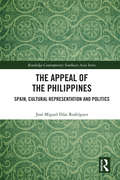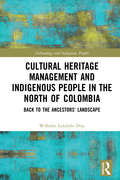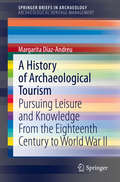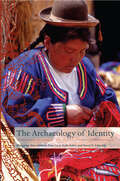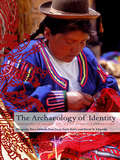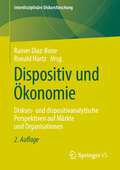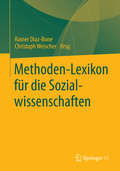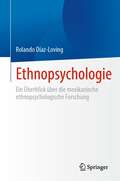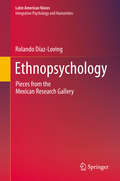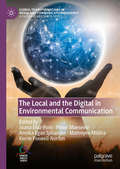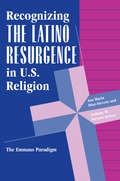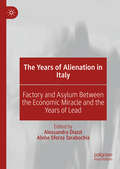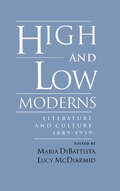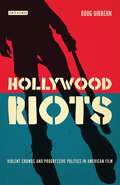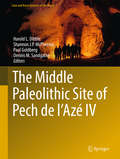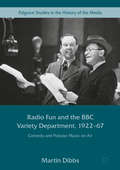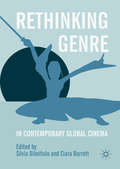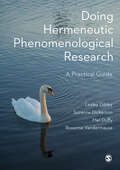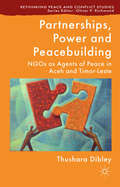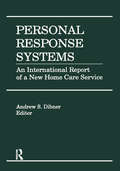- Table View
- List View
The Appeal of the Philippines: Spain, Cultural Representation and Politics (Routledge Contemporary Southeast Asia Series)
by José Miguel Díaz RodríguezThis book examines the different means through which Spain has revisited its ex-colony - the Philippines - since 2000. Focusing on several major exhibitions organised in the period 1998-2017, the ‘poetics’ (narratives and meaning) and ‘politics’ (institutional power) of Spanish representations of the Philippines are critically examined. Even though Spain’s intention was to offer a fresh and updated look at the Philippines through the events organised, there was also a tendency to refer to and recreate a colonial past, posing important questions about the continuity of conceptions concerning the old Spanish Empire in the 21st Century. Díaz Rodríguez further analyses Spanish cultural policy concerned with cultural promotion outside Spain and, in particular, in the Philippines. He considers the Spanish official approach to cultural exchange in the Philippines and the consequences of particular intercultural events supported by Spanish institutions in the Philippines. This is evidenced by unique data gathered from a number of interviews conducted by the author with Spanish and Filipino artists and cultural workers. His conclusions contribute to the understanding of the transnational movement of culture, including cultural representation, arts funding, and the links between politics and the arts.
Cultural Heritage Management and Indigenous People in the North of Colombia: Back to the Ancestors' Landscape (Archaeology and Indigenous Peoples)
by Wilhelm Londoño DíazCultural Heritage Management and Indigenous People in the North of Colombia explores indigenous people's struggle for territorial autonomy in an aggressive political environment and the tensions between heritage tourism and Indigenous rights. South American cases where local communities, especially Indigenous groups, are opposed to infrastructure projects, are little known. This book lays out the results of more than a decade of research in which the resettlement of a pre-Columbian village has been documented. It highlights the difficulty of establishing the link between archaeological sites and objects, and Indigenous people due to legal restrictions. From a decolonial framework, the archaeology of Pueblito Chairama (Teykú) is explored, and the village stands as a model to understand the broader picture of the relationship between Indigenous people and political and economic forces in South America. The book will be of interest to researchers in Archaeology, Anthropology, Heritage and Indigenous Studies who wish to understand the particularities of South American repatriation cases and Indigenous archaeology in the region.
Cultural Heritage Management and Indigenous People in the North of Colombia: Back to the Ancestors' Landscape (Archaeology and Indigenous Peoples)
by Wilhelm Londoño DíazCultural Heritage Management and Indigenous People in the North of Colombia explores indigenous people's struggle for territorial autonomy in an aggressive political environment and the tensions between heritage tourism and Indigenous rights. South American cases where local communities, especially Indigenous groups, are opposed to infrastructure projects, are little known. This book lays out the results of more than a decade of research in which the resettlement of a pre-Columbian village has been documented. It highlights the difficulty of establishing the link between archaeological sites and objects, and Indigenous people due to legal restrictions. From a decolonial framework, the archaeology of Pueblito Chairama (Teykú) is explored, and the village stands as a model to understand the broader picture of the relationship between Indigenous people and political and economic forces in South America. The book will be of interest to researchers in Archaeology, Anthropology, Heritage and Indigenous Studies who wish to understand the particularities of South American repatriation cases and Indigenous archaeology in the region.
A History of Archaeological Tourism: Pursuing leisure and knowledge from the eighteenth century to World War II (SpringerBriefs in Archaeology)
by Margarita Díaz-AndreuThis book examines the relationship between archaeological tourism and professional archaeology. It will do so by looking at this connection – most visibly through nationalism and global capitalism - from the its origins in the early modern period until World ar II. How separate is the development of archaeological tourism from that of the formation of archaeology as a discipline? And do the fields operate in two different worlds? Scholarly discussions have largely treated them as distinct fields with no connection. Histories of archaeology, in particular, have focused their attention on aspects such as the history of archaeological discoveries, archaeological thought and, more recently, the political relationship between archaeology and nationalism and other ideologies. Largely missing from all these accounts has been an examination of how archaeology has been inserted into society, for example through something that all humans enjoy – leisure – in the form of archaeological tourism. Moreover, just as histories of archaeology have largely ignored the connection between archaeology and tourism so, too has tourism in the reverse direction. Recent studies on tourism have centered on topics such as economy (sustainable and recession tourism) and new types of tourism (including ecotourism and medical tourism).
Archaeology of Identity
by Margarita Diaz-Andreu Sam LucyBringing together a wealth of scholarship which provides a unique integrated approach to identity, The Archaeology of Identity presents an overview of the five key areas which have recently emerged in archaeological social theory: * gender* age* ethnicity* religion * status. This excellent book reviews the research history of each areas, the different ways in which each has been investigated, and offers new avenues for research and exploring the connections between them. Emphasis is placed on exploring the ways in which material culture structures, and is structured by, these aspects of individual and communal identity, with a particular examination of social practice. Useful for social scientists in sociology, anthropology and history, under- and postgraduates will find this an excellent addition to their course studies.
Archaeology of Identity
by Margarita Diaz-Andreu Sam LucyBringing together a wealth of scholarship which provides a unique integrated approach to identity, The Archaeology of Identity presents an overview of the five key areas which have recently emerged in archaeological social theory: * gender* age* ethnicity* religion * status. This excellent book reviews the research history of each areas, the different ways in which each has been investigated, and offers new avenues for research and exploring the connections between them. Emphasis is placed on exploring the ways in which material culture structures, and is structured by, these aspects of individual and communal identity, with a particular examination of social practice. Useful for social scientists in sociology, anthropology and history, under- and postgraduates will find this an excellent addition to their course studies.
Dispositiv und Ökonomie: Diskurs- und dispositivanalytische Perspektiven auf Märkte und Organisationen (Interdisziplinäre Diskursforschung)
by Rainer Diaz-Bone Ronald HartzDer in zweiter Auflage vorliegende Band bietet einen aktuellen Überblick über die Vielzahl neuerer sozialwissenschaftlicher Forschungen zur Bedeutung, Funktion und Theorie von Dispositiven in und für die Ökonomie. Denn die Ökonomie ist „instrumentiert“ – Organisationen und Märkte sind durchzogen und ausgestattet mit Objekten, Materialitäten, Technologien, Diskursen und Subjektivierungsweisen, deren spezifische Verknüpfungen die Ökonomie hervorbringen. Für die Analyse der Dispositive muss „Ökonomie“ daher notwendig transdisziplinär gefasst werden, gerade um die bisher weitgehende Ausblendung von Dispositiven in der Analyse von Märkten und Organisationen zu überwinden und diese durch neuartige theoretische aber auch vielfältige methodologische Zugänge zu erschließen. Diese Erschließung der materiellen und immateriellen Ausstattung der Ökonomie erfolgt nun nicht nur transdisziplinär, sondern auch international. Der Band präsentiert Beiträge von Forschenden aus Deutschland, Frankreich, Großbritannien und der Schweiz. Die durchgesehene und korrigierte Neuauflage wurde um eine Bibliographie neuerer Arbeiten ergänzt.
Methoden-Lexikon für die Sozialwissenschaften
by Rainer Diaz-Bone Christoph WeischerDas Buch gibt einen umfassenden und dringend benötigten, lexikalischen Überblick zu den Methoden der empirischen Sozialforschung.
Ethnopsychologie: Ein Überblick über die mexikanische ethnopsychologische Forschung
by Rolando Díaz-LovingDieses Buch gibt einen Überblick über die mexikanische Ethnopsychologie, einen originellen theoretischen und methodischen Ansatz, der darauf abzielt, die auf universellen Prinzipien, Prozessen und Konstrukten basierende psychologische Wissenschaft durch wissenschaftliche Methoden zu ergänzen, um die für bestimmte kulturelle Gruppen typischen idiosynkratischen Merkmale und Verhaltensweisen zu untersuchen. Sie schlägt ein historisch-bio-psycho-sozio-kulturelles theoretisches Modell vor, um Forschungsergebnisse zu sozialen, psychologischen, kollektiven und individuellen Phänomenen zu beschreiben.Die Psychologie steht am Scheideweg einer jahrelangen Forschung, bei der der Schwerpunkt auf der internen Validität lag und kontextuelle und kulturelle Variablen kaum beachtet wurden. Es ist von grundlegender Bedeutung, den Weg der internen Validität weiterzuverfolgen und gleichzeitig Fragen der externen Validität einzubeziehen. Die Zunahme indigener Bewegungen und Daten ermöglicht eine gründliche Bewertung der Frage, inwieweit scheinbar universelle Phänomene wirklich universell sind und inwieweit sie idiosynkratische Manifestationen der Kulturen sind, in denen die Mainstream-Forschung betrieben wird.Mexikanische Ethnopsychologen verfolgen diesen Weg schon seit Jahrzehnten, seit der Pionierarbeit von Rogelio Díaz-Guerrero, aber bisher wurde nur wenig über diesen innovativen theoretischen Ansatz in englischer Sprache veröffentlicht. Ethnopsychologie - Stücke aus der mexikanischen Forschungsgalerie füllt diese Lücke, indem es der internationalen Gemeinschaft einen Überblick über die mexikanische Ethnopsychologie gibt und somit ein nützliches Instrument für Verhaltens-, Sozial- und Gesundheitswissenschaftler darstellt, die daran interessiert sind, zu verstehen, wie die Kultur sowohl kollektive als auch individuelle Verhaltensweisen prägt.
Ethnopsychology: Pieces from the Mexican Research Gallery (Latin American Voices)
by Rolando Díaz-LovingThis book presents an overview of Mexican ethnopsychology, an original theoretical and methodological approach that seeks to complement the mainstream psychological science – based on universal principles, processes and constructs – with scientific methods to study the idiosyncratic features and behaviors typical of specific cultural groups. It proposes a historic-bio-psycho-socio-cultural theoretical model to describe research findings of social, psychological, collective and individual phenomena. Psychology is at a crossroads of years of research with stress on internal validity and little attention to contextual and cultural variables. It becomes fundamental to continue on the internal validity track but at the same time incorporate external validity issues. The growth of indigenous movements and data allows for a profound evaluation of the extents to which apparent universal phenomena are truly universal, and to what extent they are idiosyncratic manifestations of the cultures where the mainstream research is conducted. Mexican ethnopsychologists have been following this path for decades, since the pioneer work of Rogelio Díaz-Guerrero, but until now little has been published in English about this innovative theoretical approach. Ethnopsychology – Pieces from the Mexican Research Gallery fills this gap by presenting the international community an overview of Mexican ethnopsychology and thus providing a useful tool to behavioral, social and health scientists interested in understanding how culture shapes both collective and individual behaviors.
The Local and the Digital in Environmental Communication (Global Transformations in Media and Communication Research - A Palgrave and IAMCR Series)
by Joana Díaz-Pont Pieter Maeseele Annika Egan Sjölander Maitreyee Mishra Kerrie Foxwell-NortonThis volume interrogates the intertwining of the local and the digital in environmental communication. It starts by introducing a wave metaphor to tease out major shifts in the field, and situates the intersections of local places and digital networks in the beginning of a third wave. Investigations that feature the centrality of place and digital communication platforms show how we today, as researchers and practitioners, communicate the environment. Contributions identify the need for critical approaches that engage with the wider consequences of this changing media landscape, unpacking local and global tensions in environmental communication research. This empirical case study collection from different parts of the world shows that environmental activists and citizens creatively use digital technologies for campaign purposes. It identifies new environmental communication challenges and opportunities, as well as practices, of environmental activists, NGOs, citizens and local communities, in the fight for social and environmental justice.
Recognizing The Latino Resurgence In U.s. Religion: The Emmaus Paradigm
by Ana Maria Diaz-stevensThis book delivers a knockout blow to the old notion that Latinos and Latinas are just another immigrant group waiting to be assimilated. Taking as analogy the scriptural episode of Emmaus in which Jesus walked unrecognized alongside his disciples, the authors detail how after nearly a century of unrecognized presence, the nations more than 25 million Latinos and Latinas began, in 1967, to use religion as a major source of the social and symbolic capital to fortify their identity in American society. Ana Mara Daz-Stevens and Anthony M. Stevens-Arroyo describe how this Latino Religious Resurgence has created a church-based model of multicultural pluralism that challenges the current trend of U.S. politics. }Emmaus is the biblical episode that recounts how the disciples, who had been unable to recognize the resurrected Jesus even as he traveled with them, finally come to know him as their Lord through his inspirational conversation. In this major new work exploring Latino religion, Ana Mara Daz-Stevens and Anthony M. Stevens-Arroyo compare a century-old presence of Latinos and Latinas under the U.S. flag to the Emmaus account. They convincingly argue for a new paradigm that breaks with the conventional view of Latinos and Latinas as just another immigrant group waiting to be assimilated into the U.S. The authors suggest instead the concept of a colonized people who now are prepared to contribute their cultural and linguistic heritage to a multicultural and multilingual America.The first chapter provides an overview of the religious and demographic dynamics that have contributed a specifically Latino character to the practice of religion among the 25 million plus members of what will become the largest minority group in the U.S. in the twenty-first century. The next two chapters offer challenging new interpretations of tradition and colonialism, blending theory with multiple examples from historical and anthropological studies on Latinos and Latinas. The heart of the book is dedicated to exploring what the authors call the Latino Religious Resurgence, which took place between 1967 and 1982. Comparing this period to the Great Awakenings of Colonial America and the Risorgimento of nineteenth-century Italy, the authors describe a unique combination of social and political forces that stirred Latinos and Latinas nationally. Utilizing social science theories of social movement, symbolic capital, generational change, a new mentalit, and structuration, the authors explain why Latinos and Latinas, who had been in the U.S. all along, have only recently come to be recognized as major contributors to American religion. The final chapter paints an optimistic role for religion, casting it as a binding force in urban life and an important conduit for injecting moral values into the public realm.Offering an extensive bibliography of major works on Latino religion and contemporary social science theory, Recognizing the Latino Resurgence in U. S. Religion makes an important new contribution to the fields of sociology, religious studies, American history, and ethnic and Latino studies.
The Years of Alienation in Italy: Factory and Asylum Between the Economic Miracle and the Years of Lead
by Alessandra Diazzi Alvise Sforza TarabochiaThe Years of Alienation in Italy offers an interdisciplinary overview of the socio-political, psychological, philosophical, and cultural meanings that the notion of alienation took on in Italy between the 1960s and the 1970s. It addresses alienation as a social condition of estrangement caused by the capitalist system, a pathological state of the mind and an ontological condition of subjectivity. Contributors to the edited volume explore the pervasive influence this multifarious concept had on literature, cinema, architecture, and photography in Italy. The collection also theoretically reassesses the notion of alienation from a novel perspective, employing Italy as a paradigmatic case study in its pioneering role in the revolution of mental health care and factory work during these two decades.
High And Low Moderns: Literature And Culture, 1889-1939
by Maria DiBattista Lucy McDiarmidThis collection of essays on modernist culture reassesses the convergence of low and high cultures, of socialist and aesthete, late Victorian and young Georgian, the popular and the coterie. Academic literary studies have until recently preferred to treat the "opaque," "difficult" writings of high moderns Conrad, Yeats, Woolf, and Eliot, and the more accessible work of the low moderns Kipling, Shaw, and Wells in separate categories. In contributions by scholars David Bromwich, Roy Foster, Edna Longley, Louis Menand, Edward Mendelson, and others,High and Low Modernsbrings these writers into critical proximity. Essays on such topics as the public mourning of Queen Victoria, Florence Farr and the "New Woman," the Edwardian Shaw, Lady Gregory's attraction to Irish felons, and the high artistic uses of low entertainments--cinema, detective fiction, and journalism-- introduce a subtler model of modernism, in which "demotic" and "elite" cultural forms criticize, imitate, and address one another.
Hollywood Riots: Violent Crowds and Progressive Politics in American Film (Cinema and Society #Vol. 20)
by Doug DibbernThe large literature about the politics of Hollywood in the period of McCarthy and the blacklist has largely overlooked political filmmaking during those agitated years. Hollywood Riots examines the most vibrant cycle of independently produced political films made while House Committee on Un-American Activities was investigating communists in the film industry. In doing so, it shifts the focus from the politics of Washington to the politics of Los Angeles and from the films of the Hollywood Ten to the more politically complex films of the progressive community at large. Dibbern shows how the movies produced by progressives at the end of the 1950s, including The Lawless, The Sound of Fury, The Underworld , were the logical cinematic parallel to their political and journalistic advocacy fighting the conservative newspapers. In these films they were recasting political events from California's recent past as politically-engaged narratives that were inflected with their own fears of persecution. Hollywood Riots re-views the work of notable directors like Joseph Losey and Cy Endfield, as well as introducing unheralded political screenwriters and directors such as Daniel Mainwaring, Jo Pagano, and Leo C. Popkin.
The Middle Paleolithic Site of Pech de l'Azé IV (Cave and Karst Systems of the World)
by Harold L. Dibble Shannon J. McPherron Paul Goldberg Dennis M. SandgatheThis book provides comprehensive information on the materials excavated at Pech de l’Azé IV, both by the original excavator François Bordes in the 1970s, and more recently by the authors and their scientific team. Applying a range of new excavation and analytical techniques, it presents detailed material on the formation of the site, its chronology and the nature of the hominin occupations. Pech de l’Azé IV is part of a complex of Lower and Middle Paleolithic cave sites in the Dordogne Valley of southwestern France. Although this region is well known for its rich concentration of Paleolithic sites since the mid-19th century and many of the sites have been repeatedly excavated, no detailed studies have fully documented the stone tool technology and faunal remains or the changes in them over time. The site was regularly occupied by groups of Neanderthals from approximately 100,000 to 40,000 years ago, during which time global-scale changes transformed the region from a relatively warm climate (similar to today’s) to a very cold, glacial one. The site provides valuable insights into changes in Neanderthal behavior that reflect, at least in part, their adaptation to changes in the environment and the availability of important resources, such as prey species.
Radio Fun and the BBC Variety Department, 1922-67: Comedy and Popular Music on Air (Palgrave Studies in the History of the Media)
by Martin DibbsThis book provides a narrative history of the BBC Radio Variety Department exploring, along chronological lines, the workings of, tensions within and the impact of BBC policies on the programme-making department which generated the organisation’s largest audiences. It provides an insight into key events, personalities, programmes, internal politics and trends in popular entertainment, censorship and anti-American policy as they individually or collectively affected the Department. Martin Dibbs examines how the Department's programmes became markers in the daily and weekly lives of millions of listeners, and helped shape the nation's listening habits when radio was the dominant source of domestic entertainment. The book explores events and topics which, while not directly forming part of the Variety Department’s history, nevertheless intersected with or had an impact on it. Such topics include the BBC’s attitude to jazz and rock and roll, the arrival of television with its impact on radio, the pirate radio stations, and the Popular Music and Gramophone Departments, both of whom worked closely with the Variety Department.
Rethinking Genre in Contemporary Global Cinema
by Silvia Dibeltulo Ciara BarrettRethinking Genre in Contemporary Global Cinema offers a unique, wide-ranging exploration of the intersection between traditional modes of film production and new, transitional/transnational approaches to film genre and related discourses in a contemporary, global context. This volume’s content—the films, genres, and movements explored, as well as methodologies used in their analysis—is diverse and, crucially, up-to-date with contemporary film-making practice and theory. Significantly, the collection extends existing scholarly discourse on film genre beyond its historical bias towards a predominant focus on Hollywood cinema, on the one hand, and a tendency to treat “other” national cinemas in isolation and/or as distinct systems of production, on the other. In view of the ever-increasing globalisation and transnational mediation of film texts and screen media and culture worldwide, the book recognises the need for film genre studies and film genre criticism to cast a broader, indeed global, scope. The collection thus rethinks genre cinema as a transitional, cross-cultural, and increasingly transnational, global paradigm of film-making in diverse contexts.
Rethinking Genre in Contemporary Global Cinema
by Silvia Dibeltulo Ciara BarrettRethinking Genre in Contemporary Global Cinema offers a unique, wide-ranging exploration of the intersection between traditional modes of film production and new, transitional/transnational approaches to film genre and related discourses in a contemporary, global context. This volume’s content—the films, genres, and movements explored, as well as methodologies used in their analysis—is diverse and, crucially, up-to-date with contemporary film-making practice and theory. Significantly, the collection extends existing scholarly discourse on film genre beyond its historical bias towards a predominant focus on Hollywood cinema, on the one hand, and a tendency to treat “other” national cinemas in isolation and/or as distinct systems of production, on the other. In view of the ever-increasing globalisation and transnational mediation of film texts and screen media and culture worldwide, the book recognises the need for film genre studies and film genre criticism to cast a broader, indeed global, scope. The collection thus rethinks genre cinema as a transitional, cross-cultural, and increasingly transnational, global paradigm of film-making in diverse contexts.
Doing Hermeneutic Phenomenological Research: A Practical Guide
by Lesley Dibley Suzanne Dickerson Mel Duffy Roxanne VandermauseThis practical guide offers an approachable introduction to doing hermeneutic phenomenological research across the health and social sciences. Grounded in real world research, it integrates philosophy, methodology and method in accessible ways, helping you realize the potential of using phenomenology to guide research. The book maps the complete research process and shows how to apply key philosophical tenets to your project, demonstrating the close relationship between philosophy and research practice. It: Shows step-by-step how to translate philosophy into research methodology and turn methodology into robust research design Focuses on applied practice, illustrating theoretical discussions with examples and case studies Promotes advanced thinking about hermeneutic phenomenology in an easy to understand way Highlights the need for researchers to engage reflexively with the whole research process.
Doing Hermeneutic Phenomenological Research: A Practical Guide
by Lesley Dibley Suzanne Dickerson Mel Duffy Roxanne VandermauseThis practical guide offers an approachable introduction to doing hermeneutic phenomenological research across the health and social sciences. Grounded in real world research, it integrates philosophy, methodology and method in accessible ways, helping you realize the potential of using phenomenology to guide research. The book maps the complete research process and shows how to apply key philosophical tenets to your project, demonstrating the close relationship between philosophy and research practice. It: Shows step-by-step how to translate philosophy into research methodology and turn methodology into robust research design Focuses on applied practice, illustrating theoretical discussions with examples and case studies Promotes advanced thinking about hermeneutic phenomenology in an easy to understand way Highlights the need for researchers to engage reflexively with the whole research process.
Doing Hermeneutic Phenomenological Research: A Practical Guide
by Lesley Dibley Suzanne Dickerson Mel Duffy Roxanne VandermauseThis practical guide offers an approachable introduction to doing hermeneutic phenomenological research across the health and social sciences. Grounded in real world research, it integrates philosophy, methodology and method in accessible ways, helping you realize the potential of using phenomenology to guide research. The book maps the complete research process and shows how to apply key philosophical tenets to your project, demonstrating the close relationship between philosophy and research practice. It: Shows step-by-step how to translate philosophy into research methodology and turn methodology into robust research design Focuses on applied practice, illustrating theoretical discussions with examples and case studies Promotes advanced thinking about hermeneutic phenomenology in an easy to understand way Highlights the need for researchers to engage reflexively with the whole research process.
Partnerships, Power and Peacebuilding: NGOs as Agents of Peace in Aceh and Timor-Leste (Rethinking Peace and Conflict Studies)
by T. DibleyBy highlighting the scope and limitations of local NGO agencies, this book presents a unique perspective of the relationship between peacebuilding theory and its application in practice, outlining how well-educated, well-connected local decision makers and thinkers navigate the uneven power dynamics of the international aid system.
Personal Response Systems: An International Report of a New Home Care Service
by Andrew S DibnerThis important new book describes the origins, developments, and current status of personal response systems, a new means for persons at risk who live alone to get help in case of emergency. In Personal Response Systems, experts from ten countries report on the status, achievements, and challenges involved in setting up, distributing, and operating personal response systems (PRS). Experienced authors from a variety of backgrounds describe the technology, economics, and social effects of PRS, and its integration into existing health and housing programs. Professionals who provide home health services will find important information about the most efficient and cost effective designs of personal response systems. They will learn how to evaluate and recommend the most appropriate systems for their clients with the assistance of this valuable new book. Research on the frequency and types of emergencies and the many psychological and social benefits to users of this new technology and their families are also discussed. Personal Response Systems covers systems in a number of countries, including Japan, Israel, Sweden, New Zealand, and Germany. Authors representing universities, social agencies, and manufacturing plants provide a balanced, thorough presentation of the subject. These authors discuss: the technology of personal response systems demographic trends how to set up a PRS in a community the integration of PRS into housing for the elderly and disabled benefits to consumers and health care systems the effects of PRS on family relationships emergencies best suited for PRS analysis of how future technology will expand the medical and protective functions of PRSHealth care planners, social workers, physicians, case managers, housing developers and managers, and others involved in caring for the elderly or disabled will find a valuable store of information in this comprehensive volume. They will be able to evaluate more quickly the most appropriate PRS services for their clients and tenants.
Personal Response Systems: An International Report of a New Home Care Service
by Andrew S DibnerThis important new book describes the origins, developments, and current status of personal response systems, a new means for persons at risk who live alone to get help in case of emergency. In Personal Response Systems, experts from ten countries report on the status, achievements, and challenges involved in setting up, distributing, and operating personal response systems (PRS). Experienced authors from a variety of backgrounds describe the technology, economics, and social effects of PRS, and its integration into existing health and housing programs. Professionals who provide home health services will find important information about the most efficient and cost effective designs of personal response systems. They will learn how to evaluate and recommend the most appropriate systems for their clients with the assistance of this valuable new book. Research on the frequency and types of emergencies and the many psychological and social benefits to users of this new technology and their families are also discussed. Personal Response Systems covers systems in a number of countries, including Japan, Israel, Sweden, New Zealand, and Germany. Authors representing universities, social agencies, and manufacturing plants provide a balanced, thorough presentation of the subject. These authors discuss: the technology of personal response systems demographic trends how to set up a PRS in a community the integration of PRS into housing for the elderly and disabled benefits to consumers and health care systems the effects of PRS on family relationships emergencies best suited for PRS analysis of how future technology will expand the medical and protective functions of PRSHealth care planners, social workers, physicians, case managers, housing developers and managers, and others involved in caring for the elderly or disabled will find a valuable store of information in this comprehensive volume. They will be able to evaluate more quickly the most appropriate PRS services for their clients and tenants.
